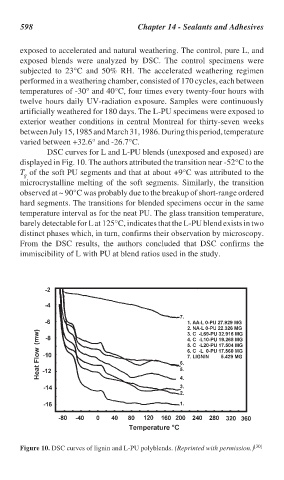Page 631 - Handbook of Thermal Analysis of Construction Materials
P. 631
598 Chapter 14 - Sealants and Adhesives
exposed to accelerated and natural weathering. The control, pure L, and
exposed blends were analyzed by DSC. The control specimens were
subjected to 23°C and 50% RH. The accelerated weathering regimen
performed in a weathering chamber, consisted of 170 cycles, each between
temperatures of -30° and 40°C, four times every twenty-four hours with
twelve hours daily UV-radiation exposure. Samples were continuously
artificially weathered for 180 days. The L-PU specimens were exposed to
exterior weather conditions in central Montreal for thirty-seven weeks
between July 15, 1985 and March 31, 1986. During this period, temperature
varied between +32.6° and -26.7°C.
DSC curves for L and L-PU blends (unexposed and exposed) are
displayed in Fig. 10. The authors attributed the transition near -52°C to the
T of the soft PU segments and that at about +9°C was attributed to the
g
microcrystalline melting of the soft segments. Similarly, the transition
observed at ~ 90°C was probably due to the breakup of short-range ordered
hard segments. The transitions for blended specimens occur in the same
temperature interval as for the neat PU. The glass transition temperature,
barely detectable for L at 125°C, indicates that the L-PU blend exists in two
distinct phases which, in turn, confirms their observation by microscopy.
From the DSC results, the authors concluded that DSC confirms the
immiscibility of L with PU at blend ratios used in the study.
Figure 10. DSC curves of lignin and L-PU polyblends. (Reprinted with permission.) [30]

